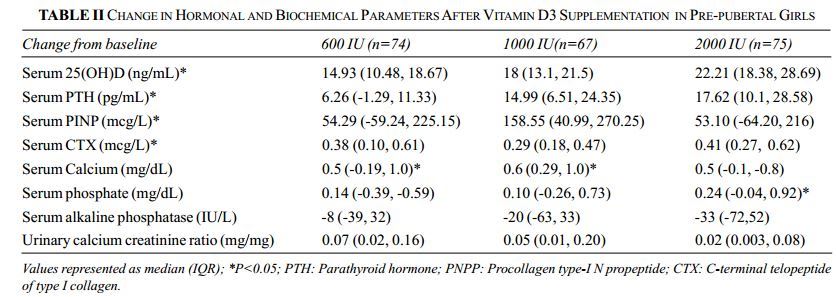All preteen aged girls in India taking 2,000 IU of vitamin D got levels above 20 ng – RCT
Supplementation with Three Different Daily Doses of Vitamin D3 in Healthy Pre-pubertal School Girls: A Cluster Randomized Trial Nov 2018
Indian Pediatrics, Nov 2018, Vol 55,Issue 11, pp 951–956 https://doi.org/10.1007/s13312-018-1416-z
RAMAN KUMAR MARWAHA1, A MITHAL2, NEETU BHARI3, G SETHURAMAN3, SUSHIL GUPTA4, MANOJ SHUKLA4,
ARCHANA NARANG 5, ADITI CHADDA5, NANDITA GUPTA6, V SREENIVAS7 AND MA GANIE6
From 1International Life Sciences Institute (India); 2Medanta Hospital Gurgaon, Haryana; Departments of 3Dermatology,
6Endocrinology and 7Biostatistics, AIIMS, New Delhi; 4SGPGI, Lucknow, Uttar Pradesh; and 5Dr BR Sur Homeopathic Medical
College, New Delhi; India.
Correspondence to: Maj Gen Raman Kumar Marwaha, Scientific Advisor (Projects), International Life Science Institute (India).
marwaha_ramank@hotmail.com.
PDF is available free at Sci-Hub 10.1007/s13312-018-1416-z

Objective: To compare the adequacy and efficacy of different doses of vitamin D3 in pre-pubertal girls.
Design: Cluster Randomized controlled trial.
Setting: Public school in Delhi, India, between August 2015 and February 2016.
Participants: 216 healthy pre-pubertal girls, aged 6.1-11.8 years.
Intervention: Daily supplementation with 600 IU (n=74), 1000 IU (n=67) or 2000 IU (n=75) of vitamin D3 under supervision for 6 months.
Outcome measures: Primary: Rise in serum 25 hydroxy Vitamin D (25(OH)D); Secondary: Change in bone formation and resorption markers.
Results
Following 6 months of supplementation, the mean (SD) rise in serum 25(OH)D was maximum with 2000 IU (24.09 (8.28) ng/mL), followed by with 1000 IU (17.96 (6.55) ng/mL) and 600 IU (15.48 (7.00) ng/mL). Serum 25(OH)D levels of ≥20 ng/mL were seen in 91% in 600 IU group, 97% in 1000 IU group and 100% in 2000 IU group . The overall mean (SD) rise in urinary calcium creatinine ratio (0.05 (0.28) to 0.13 (0.12) mg/mg), and serum procollagen type I N-terminal propeptide (538.9 (199.78) to 655.5 (218.24) ng/mL), and reduction in serum carboxy-terminal telopeptide (0.745 (0.23) to 0.382 (0.23) ng/mL) was significant (P<0.01). The change in the above parameters was comparable among the three groups after adjustment for age.
Conclusion: Daily vitamin D supplementation with 600 IU to 2000 IU for 6 months results in Vitamin D sufficiency in >90% of prepubertal girls.
Most deficient schoolchildren got > 20 ng with 2,000 IU daily - RCT March 2019
Impact of three different daily doses of vitamin D3 supplementation in healthy schoolchildren and adolescents from North India: a single-blind prospective randomised clinical trial.
Br J Nutr. 2019 Mar;121(5):538-548. doi: 10.1017/S0007114518003690.
Marwaha RK1, Garg MK2, Sethuraman G3, Gupta N4, Mithal A5, Dang N6, Kalaivani M7, Ashraf Ganie M4, Narang A8, Arora P9, Singh A9, Chadha A8, Manchanda RK9.
In India, there is a lack of information about the adequate daily dose of vitamin D3 supplementation in school children. Hence, we undertook this study to evaluate the adequacy and efficacy of different doses of vitamin D3 in schoolchildren. A total of 1008 vitamin D-deficient (VDD) children, aged 6-16 years with serum 25-hydroxyvitamin D (25(OH)D) levels <50nmol/l, were cluster randomised into three groups (A-344, B-341 and C-232) for supplementation (600, 1000 and 2000 IU daily) of vitamin D3 under supervision for 6 months. Of the 1008 subjects who completed the study, 938 (93 %) were compliant. Baseline and post-supplementation fasting blood and urine samples were evaluated for Ca, phosphates, alkaline phosphatase, 25(OH)D and parathormone and urine Ca:creatinine ratio. The mean age of the subjects was 11·7 (sd 2·4) years, and the overall mean baseline serum 25(OH)D level was 24·3 (SD 9·5)nmol/l. Post-supplementation rise in serum 25(OH)D in compliant group was maximum with 2000 IU (70·0 (SD 30·0)nmol/l), followed by 1000 IU (46·8 (SD 22·5)nmol/l) and 600 IU (36·5 (SD 18·5)nmol/l), and serum 25(OH)D levels of ≥50nmol/l were achieved in 71·5, 81·8 and 92·9 % by groups A, B and C, respectively. Secondary hyperparathyroidism decreased from 31·7 to 8·4 % post-supplementation. Two participants developed hypercalciuria, but none developed hypercalcaemia. Children with VDD benefit maximum with the daily supplementation of 2000 IU of vitamin D3. Whether recommendations of 400 IU/d by Indian Council of Medical Research or 600 IU by Indian Academy of Pediatrics or Institute of Medicine would suffice to achieve vitamin D sufficiency in children with VDD remains debatable.
